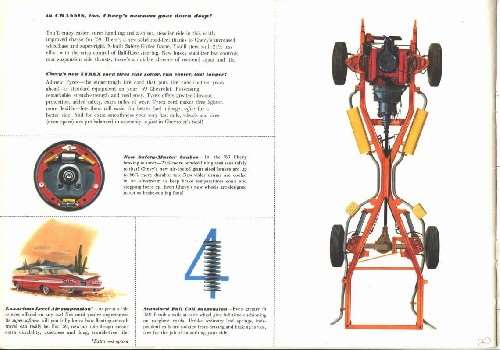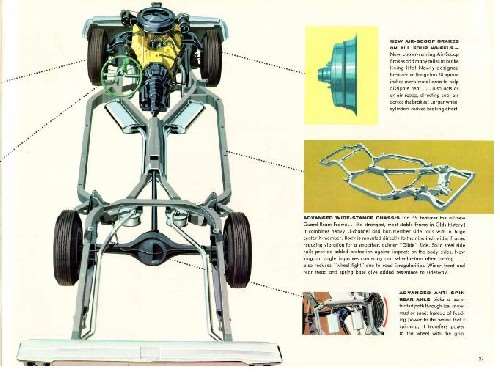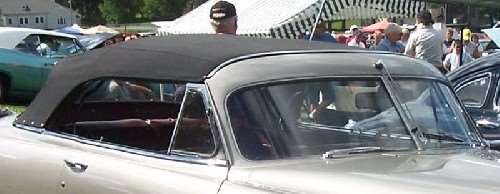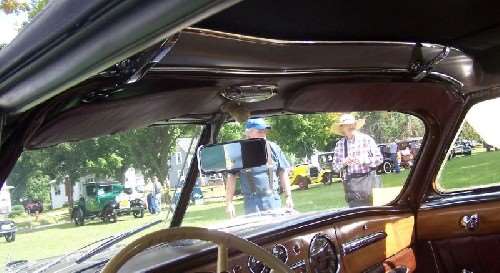|
Re: SP merger
|
||||
|---|---|---|---|---|
|
Home away from home

|
Quote:
Yup. A luxury brand would be expected to have an older, more conservative clientele. Too low seating, or two low a roof, or difficult egress would alienate them. Remember how Barit insisted the Jet have enough headroom for him to wear a hat in the back seat? Not as big a deal as he thought it was in a compact, like the Jet, but my suspicion is he was right about headroom, when it came to people of his age and wealth. Packard could have gone either way, unibody or BoF, and gotten the footwells. My mom's 72 Torino was BoF, and had footwells front and back. Where the film you linked to shows the BoF Merc having the body overhanging the frame rails, that was the old way of doing it. Pix of the 55 Packard frame show it was made the same way, with the body supported by outriggers from the frame rails. A few years later, GM went to a narrow X frame, with no outer rails at all. Then GM went to a hybrid with the narrow X frame and perimeter frame rails. What I would propose to accommodate TL and footwells would be a ladder version of the perimeter frame, rather than the X version, with the crossbraces under the seats, with the crossbraces in boxes under the seats to raise them enough to provide clearance below them for the torsion bars.
Posted on: 2015/3/22 14:30
|
|||
|
||||
|
Re: SP merger
|
||||
|---|---|---|---|---|
|
Home away from home

|
This is where careful study by product planning would have revealed the best course of action. The study needed to show advanced concepts in customer clinics.
We know from how history played out that had these clinics been accurate they would have revealed that a majority of buyers would have preferred vehicle lowness over chair height seating and hat room. Mercury tapped this future market with its 1955 Montclair. That year's brochure said that all Mercurys had a 119" wheelbase, 206.3 inch length and 76.4 inch width but that the heights varied greatly. The sedans were 61.2 inches high, the Monterey and Custom coupes were 60.3 inches and the Montclair was 58.6 inches or 2.6 inches lower than the sedans. And yet sales of the Montclair, which was the most expensive Mercury to date and a few hundred dollars more than the Monterey, were strong. How did Mercury shave 2.6 inches off the otherwise same car? What got compromised? That's what Packard and Hudson would have needed to figure out when planning their '55s... how to take 3.4 inches off the step-down to go from 60.4 to 57 inches. Maybe they wouldn't have gotten all the way there but to have gotten even 2.6 inches out would have been a win. Check out this image of a '56 Montclair. These are mature adults! Now, we don't know exactly who bought these cars but given the price, they had to be folks of some financial means, which means they were probably folks of slightly higher age. oldcarbrochures.com/static/NA/Mercury/19 ... 2/1956%20Mercury%20Hardtops-01.html We also know that by 1957 the gig was up, lowness was in for good. Well, almost. In the 1980s the revolt started, not with taller sedans but SUVs even though most were truck-based and thus very tall. They didn't replace cars but did become mainstream. Now, 30 years later, crossovers of somewhat lower height are the in-thing. Height may well come down another tick as the modern passenger vehicle continues to evolve.
Posted on: 2015/3/22 16:41
|
|||
|
||||
|
Re: SP merger
|
||||
|---|---|---|---|---|
|
Home away from home

|
btw, did some careful checking of '48-54 Hudsons in standard and hardtop form. The Hollywood appears to have used the coupe's roof. With strategic removal of metal at the roof's rear, a new backlight, sawing off of the B-piller, fitting frameless windows and new vent panes, and clever use of chrome appliques the effect gave a more low-slung appearance. The vehicle height, however, appears to have remained 60.4 inches. Somebody please correct if wrong.
Posted on: 2015/3/22 16:58
|
|||
|
||||
|
Re: SP merger
|
||||
|---|---|---|---|---|
|
Home away from home

|
Hi Paul
Hudson created the Hollywood hardtops by simply tooling up a hardtop and rear window and planting them on the convertible body. My glass book shows all windows are interchangeable between the two except the rear window, of course. Interior dimensions seat-to-roof are about the same as the sedan, but legroom like a convertible. How Ford appears to have achieved the lowered Montclair Sport Sedan is the same way they did the '55 Fairlane Crown Victoria roof structure versus the regular Fairlane Victoria, the difference is in the same range. Its simply a factory chopped top. For the Mercury, they dropped the window sills to at least give them a unique look. Given that the Ford-Mercury bodies were as 'high-pocketed' as the Contour, dropping the window sills was their only option. By the 1956 models, the lower roof heights were accepted, even expected in a top-of-the-line hardtops. Steve
Posted on: 2015/3/22 18:42
|
|||
|
.....epigram time.....
Proud 1953 Clipper Deluxe owner. Thinking about my next Packard, want a Clipper Deluxe Eight, manual shift with overdrive. |
||||
|
||||
|
Re: SP merger
|
||||
|---|---|---|---|---|
|
Home away from home

|
I figure, given Packard's market segment, their dimensions need to be compared to Cadillac. Here are some numbers for a Series 62 sedan, according to Classic Car Database
56: 64.1" 57: 61" 58: 59.1" 59: 59.1" 60: 54.3" 61: 55.8" (??, that's what it says, but I suspect that entry is wrong) 62: 54.8" 63: 54.8" Given the height of a 56 Patrician at 62", two inches lower than the 56 Cadillac, Packard need do nothing really radical until 59-60. A new frame, to allow foot wells of 2" or so depth, and a flatter roof, like the Predictor has, and they're there. Once into the early 60s, then they can go for deeper footwells and less headroom. This thread highlights the delusional hopes for the S-P merger: Packard needed a new platform, but couldn't afford it. Studebaker needed a new platform, but couldn't afford it. Studebaker's facilities would have required millions of dollars, which it didn't have, of renovation to build a platform anywhere near Packard size. We also know that by 1957 the gig was up, lowness was in for good. Well, almost. Normal passenger cars have gotten taller in the last dozen years. We are almost back to mid 50s car heights. A 70 Ford LTD was only 54.9" high. The Taurus sedan today is 60.7" high. A late 90s Ford Escort is 53.3" high. The 2000 Focus that superseded the Escort is 56.3" high. The current Focus sedan stands at 57.7" I went from a 98 Civic that was 54.1" high to a VW Jetta wagon that is 59.2" high.
Posted on: 2015/3/22 19:40
|
|||
|
||||
|
Re: SP merger
|
||||
|---|---|---|---|---|
|
Home away from home

|
Thanks Steve. The Langworth book says the convertible was built one at a time in a special room, started as a coupe, roof cut 9 inches aft of the windshield header to give a modicum of rollover strength. This is one reason I thought the Hollywood roof came from the coupe too, the cutters simply keeping more of the sheetmetal.
Regarding our search for height reduction enablers, found this little gem from the '48 brochure: "A 'six footer' in a sombrero could sit erect in the rear seat." oldcarbrochures.com/static/NA/Hudson/194 ... n_Info/1948%20Hudson%20Info-04.html
Posted on: 2015/3/22 19:52
|
|||
|
||||
|
Re: SP merger
|
||||
|---|---|---|---|---|
|
Home away from home

|
I thing what Hudson may have done was create the reverse of what the industry today calls theater seating, where the rear passengers sit higher than the front. In the case of the Hudson it appears to have been the opposite and I noticed in Steve203's link to the Hornet model car, the front seat footwell seemed higher than the rear footwell when viewed from the floorpan underside. So for our theoretical '55, might have been an opportunity to re-engineer the front understructure to lower the front floorpan and thus the front seat... and thus the vehicle height. The rear seats were already fine, sombreros and sangrias apparently the order of the day.
Posted on: 2015/3/22 20:00
|
|||
|
||||
|
Re: SP merger
|
||||
|---|---|---|---|---|
|
Home away from home

|
Hi Paul
"The Langworth book says the convertible was built one at a time in a special room, started as a coupe, roof cut 9 inches aft of the windshield header to give a modicum of rollover strength." That sounds right for Hudson's convertible building practice. From examining their pre-war convertibles in various states of deterioration and disassembly in junkyards and at Hershey over the years, the evidence of modification from coupes and handwork was very noticeable. Carrying over the practice into the postwar would make sense for them. Apparently the Step-Down broad windshield header was retained because of the internal structures need for rigidity. It looks clunky and unattractive on the Hudson and the Kaiser-Frazer convertibles, promoting it as a virtue was stretching its function a bit. Steve
Posted on: 2015/3/23 7:24
|
|||
|
.....epigram time.....
Proud 1953 Clipper Deluxe owner. Thinking about my next Packard, want a Clipper Deluxe Eight, manual shift with overdrive. |
||||
|
||||
|
Re: SP merger
|
||||
|---|---|---|---|---|
|
Forum Ambassador
|
The cutoff roof may look clunky but it appears there may be benefits too. Unlike Packard convertibles, Hudson probably didn't need a different windshield and they could keep the roof antenna. Owners needing either might be grateful then and today. Wonder if that slight roof curve helps or hinders air flow and turbulence for passengers.
Posted on: 2015/3/23 8:42
|
|||
|
Howard
|
||||
|
||||

 (95.49 KB)
(95.49 KB)










